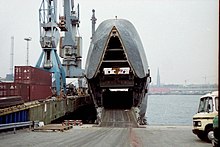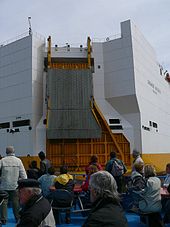Ro-Ro ship

RoRo ships (from English R oll o n R oll o ff ) are ships that transport movable goods using the RoRo method. In contrast to the LoLo procedure , this means that the cargo is driven onto the ship. This is usually a combination of vehicles such as cars or trucks or trains that can drive on board the ships themselves, as well as standardized loading units and swap bodies that are stowed on board by special tractors. For this purpose, RoRo ships have navigable decks onto which the cargo can be rolled. These are often variable in height, which means that the cargo space can be used more flexibly. For loading and unloading, RoRo ships have bow, side or stern hatches through which the vehicles can drive on board via ramps.
The advantages of the RoRo process are short turnover times, gentle cargo handling, simple port infrastructure and flexibility in the composition of the cargo. The higher construction costs are disadvantageous, since RoRo ships are special ships and are often built to meet special requirements. In addition, the use of the cargo space cannot be optimally resolved. However, within short-haul maritime transport and for some special loads (motor vehicles, paper), the advantages of RoRo systems predominate.
history
The principle of the RoRo ship was already known during the Crusades . Back then, special ships were needed to transport horses and so-called “gate ships” were built for this purpose. In 1123 the Venetians first transported horses over a long distance with numerous stops. In 1129 Hugo von Payns embarked in Marseilles with many horses, riders and infantry. During the Byzantine-Latin expedition against the port city of Damiette in Egypt in 1169, the Byzantines had rebuilt their ships so that the horses could be brought on board and ashore via a ramp.
Joinville described these "gate ships" fifty years later:
- That day the ship's gate was opened and all our horses were brought in to take us across the sea. Then you closed the gate again and sealed it tightly like you seal a barrel, because the whole gate is under water when the ship is at sea.
Thomas Bouch , whose first rail ferry was put into operation in 1851, is considered to be the inventor of modern RoRo ships . For a long time, the RoRo principle was largely restricted to rail and inland ferries. During the Second World War, landing craft were developed, the use of which after the end of the war initiated the development of RoRo ships for road vehicles. The rapid expansion of private transport then led to the extensive conversion of ferry traffic to the RoRo principle in the 1940s and 1950s. Since the 1960s, numerous RoRo freight transports have also developed, the faster turnaround times of which brought advantages, especially on short sea routes.
Today's meaning
Today, the transport of goods by RoRo ships in short and medium-haul sea traffic is an important factor. Most of the truck traffic between Finland and Western Europe (including ports in Lübeck , Rostock and Kiel ) is handled by RoRo ships. However, there are also transatlantic and global ro-ro liner services , mostly car transporters or combined transport with containers .
Special types of RoRo freighters are:
- Car transporter
- ConRo ship (combination of container and RoRo ship)
- Ferries , with or without the possibility of passenger transport
- DropShips
- LoRo ship (combination of LoLo and RoRo ship)
- Military transporter
safety
RoRo ships need large openings in the outer skin to accommodate the cargo. This represents a risk, as in the event of malfunctions or incorrect operation, large amounts of water can penetrate through these openings. In connection with the large, difficult to divide cargo holds and mostly moving cargo, this can lead to a rapid, critical change in stability that could end in a serious accident . For this reason, SOLAS stipulates multiple redundant safety systems, frequent exercises and technical reviews.
The greatest risk with RoRo ships is the large free surface area of the cargo hold. Ingress of water can spread almost unchecked in the vehicle decks. If this water is not continuously supplied to the outboard via scuppers or powerful bilge pumps , the increasing weight can lead to severe heeling and even capsizing. Despite everything, there have been some disasters on RoRo ships in the past:
- On the Herald of Free Enterprise ferry , the water entered through a bow door that was not yet closed, causing it to capsize within 90 seconds of leaving port. The International Maritime Organization reacted after the sinking and issued precise regulations for the outer skin gates and safety devices on RoRo ships.
- When the Al-Salam Boccaccio 98 sank, the fire-fighting water that collected in the vehicle deck apparently led to the heeling torque .
Outer skin gates that are not designed to be watertight (e.g. exhaust air flaps, supply hatches, etc.) can get underwater as a result of such large heels. The result is secondary flooding, through which even more water flows in and the ship finally capsizes and sinks.
Sunken RoRo ships
- Princess Victoria 1953
- Skagerak 1966
- Herakleion 1966
- Zenobia 1980
- Salem Express 1991
- Jan Heweliusz 1993
- Estonia 1994
- Express Samina 2000
- Al-Salam Boccaccio 98 2006
- Spice Islander I 2011
- Sewol 2014
- Grande America 2019
Capsized and recovered RoRo ships
- Sloman Ranger June 12, 1981 (capsized in the Mediterranean after a collision, recovered)
- Herald of Free Enterprise 1987 (capsized in Zeebrugge at the port exit, later broken up in Kaohsiung ( Taiwan ))
See also
literature
- Ralf Witthohn: New designs for versatile RoRo carriers . In: Schiff & Hafen , issue 6/2012, pp. 28–31, Seehafen-Verlag, Hamburg 2012, ISSN 0938-1643
- Car ferries - death through the gate - shipping . In: Der Spiegel . No. 53 , 1966 ( online ).
Web links
Individual evidence
- ↑ IMO and ro-ro safety . In. Focus on IMO , International Maritime Organization, January 1997.




